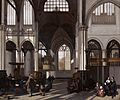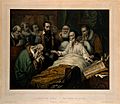Calvinism facts for kids
Calvinism is a major part of the Protestant branch of Christianity. It's named after John Calvin, an important religious leader who lived a long time ago. This way of thinking about faith is also called the Reformed tradition.
Many important thinkers helped shape Calvinism. Some were from Europe, like Martin Bucer and Huldrych Zwingli. Others were from England, such as Thomas Cranmer. John Calvin was very influential in the 1600s, which is why this tradition became known as Calvinism.
Today, Calvinism refers to the beliefs and practices of Reformed churches. These churches follow the ideas that Calvin and other early leaders taught. Two well-known ideas in Calvinism are predestination and total depravity.
How Calvinism Started
John Calvin began to influence Protestant ideas when he was just 25 years old. In 1534, he started writing his famous book, Institutes of the Christian Religion. It was published in 1536. This book, along with other writings, helped spread Calvin's ideas about how churches should be run. He was one of many who shaped the Reformed churches, but he became the most famous.
The Reformed churches grew important during the second part of the Protestant Reformation. This was after Martin Luther was removed from the Catholic Church. Calvin was a French person living in Geneva, Switzerland. He had agreed with some of Luther's ideas early on. However, his main influence came from the Swiss Reformation, which was different from Lutheranism. It followed leaders like Huldrych Zwingli and then Calvin himself.
True Calvinism teaches that God changes people's hearts. He gives them a new nature that loves God and hates sin. This is because, without God's help, people would not naturally seek Him.
Where Did Calvinism Spread?
Even though John Calvin mostly worked in Geneva, his writings helped spread his ideas across Europe. Calvinism became the main religious belief in places like Scotland (thanks to John Knox), the Netherlands, and parts of Germany. It also had a big impact in France, Hungary, and Poland. For a while, Calvinism was popular in Scandinavia, especially Sweden. But later, those countries chose Lutheranism instead.
Many early settlers in the American Mid-Atlantic and New England were Calvinists. This included the Puritans and Dutch settlers who founded New Amsterdam (now New York). Dutch Calvinist settlers were also the first successful European colonists in South Africa. They started arriving in the 17th century and became known as Boers or Afrikaners.
Some of the largest Calvinist groups today were started by 19th and 20th century missionaries. There are very large Calvinist communities in Korea and Nigeria.
See also
 In Spanish: Calvinismo para niños
In Spanish: Calvinismo para niños
Images for kids
-
Statues of important leaders like John Calvin at the International Monument to the Reformation in Geneva.
-
Calvin often preached at St. Pierre Cathedral in Geneva.
-
This 1661 painting shows a simple, early Calvinist church in Amsterdam.
-
An abandoned Calvinist church in Łapczyna Wola, Poland.
-
A Calvinist church in Semarang, Indonesia.
-
The Return of the Prodigal Son by Rembrandt, showing forgiveness.
-
The Bay Psalm Book was used by the Pilgrims in America.
-
Moïse Amyraut developed a different Calvinist idea about Christ's atonement.














